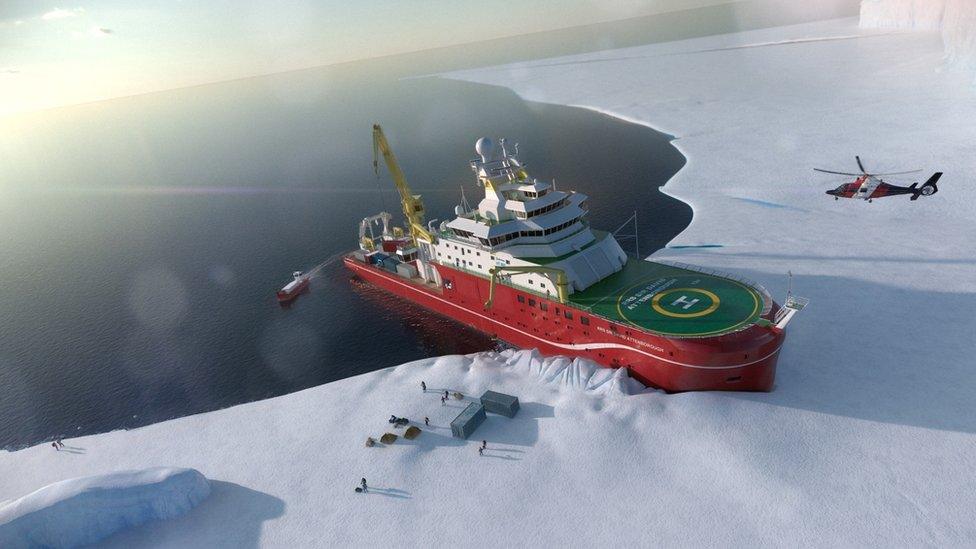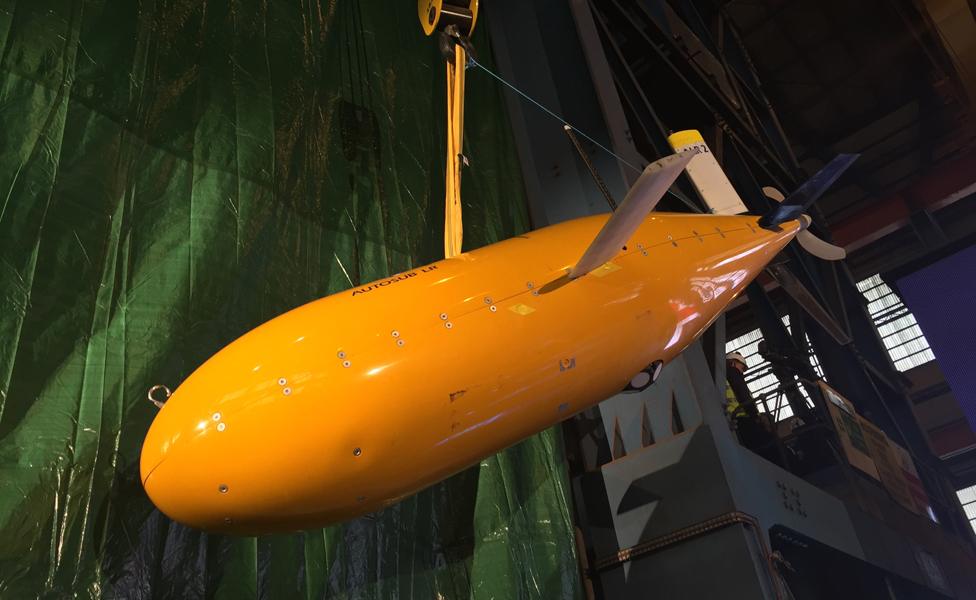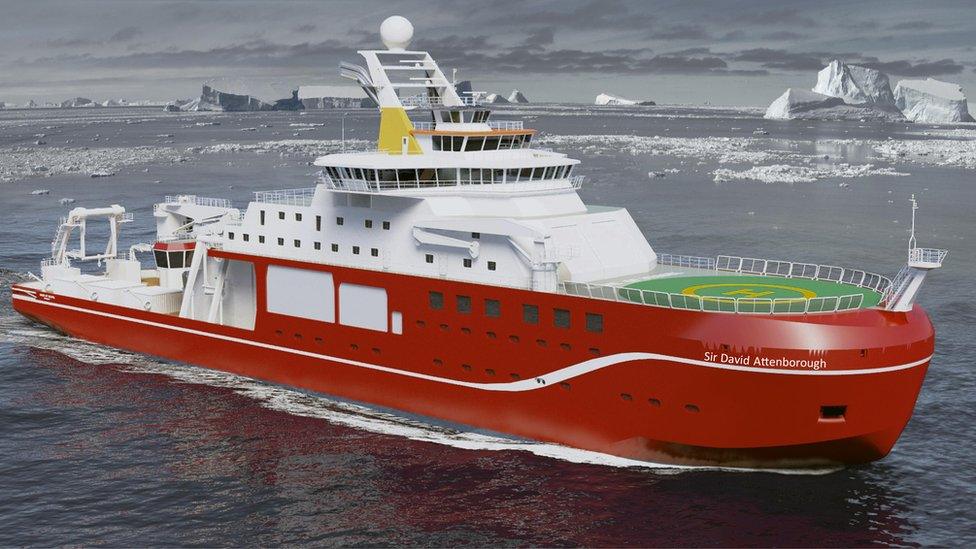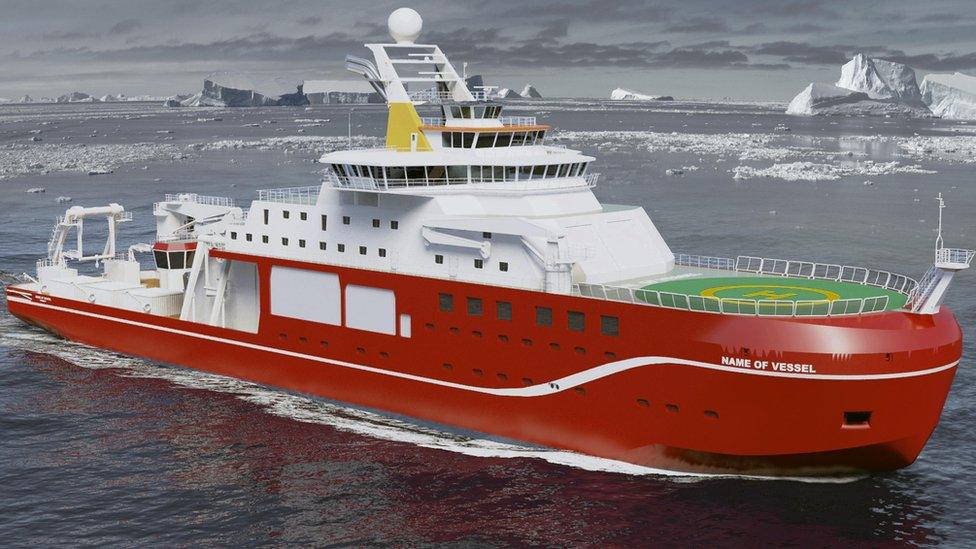Ceremony marks start of Attenborough polar ship construction
- Published

Construction of the UK's new £200m polar research ship, the RRS Sir David Attenborough, formally began on Monday at Cammell Laird on Merseyside.
A ceremony saw a crane lower a near-100-tonne segment of keel on to blocks on the firm's slipway. The ship is intended to be at work by 2019.
The vessel is already well known owing to the online vote to name it, which saw the public choose Boaty McBoatface.
An autonomous submarine deployed by the ship will be given that name instead.
The government decided that recognition of BBC TV presenter and naturalist Sir David Attenborough for the main vessel would be more fitting.
"The name Boaty has been preserved and will be whizzing around Antarctica for years to come, alongside me I'm happy to say," chuckled the veteran broadcaster.
And then, more seriously, he added: "I know that the work they will be doing onboard the new polar ship will be important, not only for science but for the whole world, because what happens down in the Antarctic is crucial for what happens to the climate of the Earth."

The RRS Sir David Attenborough will work both in the Arctic and the Antarctic
Science reporter Victoria Gill was at the shipyard for the keel laying
Cammell Laird, external's managing director, Linton Roberts, said Monday's keel-laying ceremony was an important moment for his company - an event that had drawn huge interest.
"To be honest I could have sold tickets, so many people wanted to attend," he told BBC News.
"It's another chapter in the yard's history. We've built every conceivable type of ship over the last 200 years. Obviously, we've come through a period when British shipbuilding has been in the doldrums, but we're fighting our way back and we see the RRS Sir David Attenborough as a breakout vessel to get us right up there into the top tier."
Linton Roberts: "This ship will put us in a privileged position to win more orders"
Cammell Laird believes the experience of delivering a complex project like the Attenborough will help it win future orders, not just for more research vessels but for a range of ships that might want to operate in the Arctic and the Antarctic.
There is growing interest, for example, in tourism at the poles; and regular cargo routes are likely to open up as the seasonal extent of sea-ice in the far north continues to diminish.
The Birkenhead shipbuilder signed the contract to construct the 128m-long vessel last November.
The deal committed the firm to deliver the ice-breaker in 31 months. Design work, led by Rolls-Royce, resulted in the first steel being cut in July, with the first welded unit of "Hull 1390" now ready to go on its blocks.
Sir David himself was on hand to press the button that initiated the movement of the crane and its massive load.
Tradition calls for the first keel segment to be placed atop a coin. On this occasion, it was a newly minted coin from the British Antarctic Territory (that part of Antarctica claimed by the UK).
"Once the ship is launched, we will recover the coin and we'll present it to the crew, for good luck while they sail the oceans," explained Mr Roberts.

An education programme is to be built around Boaty the submarine

Boaty the sub in diving pose at the keel-laying ceremony
Funding for the new polar ship was announced by the then chancellor, George Osborne, in April 2014.
The vessel is set to replace the UK's existing polar fleet - the RRS James Clark Ross and the RRS Ernest Shackleton - confirmed Prof Jane Francis, the director of the British Antarctic Survey, external (BAS).
The Clark Ross currently does most of the science; the Shackleton does the logistics. The Attenborough will have the capacity to perform both functions, external.
It will feature a big cargo hold, a helipad, cranes and onboard labs, and have the ability to deploy subs and other ocean survey and sampling gear.
Some of this equipment will go into the sea through an enclosed "moon pool", or "wet porch", inside the vessel.
Jane Francis: "We will have to work hard as we go from two ships to one"
"One of the things that has revolutionised our ability to study the Southern Ocean and indeed all oceans has been autonomous instruments," said Dr Emily Shuckburgh from BAS.
"Being able to send submarines underneath the surface, particularly under the ice, is helping us understand the key processes that are potentially leading to the instability of that ice, which ultimately could lead to many metres of sea-level rise."
This is where the yellow sub to be called Boaty McBoatface will make its mark.
It is a new long-range class of submersible that could travel under the entire ice-covered Arctic Ocean if required. Indeed, such a venture may well feature as one of the Attenborough's first expeditions.

All manner of autonomous vehicles will be launched from the Attenborough
Another early project is likely to be the Orchestra programme, external. This is studying how Antarctic waters and the wider Southern Ocean are helping to control the global climate by drawing down heat and carbon dioxide from the atmosphere.
Orchestra's leader, Prof Mike Meredith from BAS, believes the new ship can greatly expand the scope of data-gathering.
"The Attenborough is going to be a terrific new facility for the UK. It's a significantly bigger vessel than the James Clark Ross so it will enable us to have longer voyages and even go into different regions of the Southern Ocean where we haven't traditionally worked."
Mike Meredith: "We will hope to use the Attenborough in the Orchestra programme"
The Attenborough and Boaty are set to be the focal point on a new £1m government-funded Polar Explorer Programme, external.
The Natural Environment Research Council, external, which runs most polar science in the UK, is keen to exploit the popular interest generated around the online naming vote. Schools will be able to apply for education packs centred on ocean and polar topics.
STEM ambassadors, working to increase interest in science, technology, engineering and maths in schools, will also be working with children to bring these subjects alive.

The British Antarctic Territory crown coin will sit under the ship during its assembly
Jonathan.Amos-INTERNET@bbc.co.uk, external and follow me on Twitter: @BBCAmos, external
- Published11 May 2016

- Published12 October 2015

- Published8 May 2016

- Published6 May 2016
